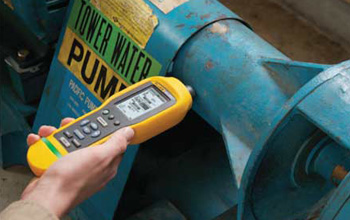Vibration Testers can provide an Early Alert System
Vibration remains one of the earliest indicators of a machine’s health.
Published with permission from Fluke Corporation.
Front Line Mechanical Maintenance Teams Need:
• A quick screening tool to fit into existing rounds.
• Reliable and repeatable measurements of rotating equipment to make imperative go/no-go maintenance decisions.
• Ability to trend readings over time and notify a consultant or reliability engineer when something abnormal arises.
• Quick understanding of overall machine and bearing condition, to decide on repairs and repair equipment.
Vibration remains one of the earliest indicators of a machine’s health
Vibration can identify problems before other symptoms, including heat, sound, electrical consumption, and lubricant impurities. More than half of unplanned downtime is attributed to mechanical failures. While many things can impact the life of a machine, once the first signs of failure appear, a machine generally has only a matter of months before failing completely. Vibration testing provides a way to determine where the machine is on the failure curve and react appropriately.
Vibration in rotating machinery is merely the back and forth movement or oscillation of a machine and components, such as drive motors, driven devices (pumps, compressors, etc.), and the bearings, shafts, gears, belts and other elements that make up mechanical systems.
Vibration itself is not the problem. Excess vibration is a symptom of internal issues, such as bearing failures, imbalance, misalignment and looseness that shorten equipment lifespan.

Benefits of vibration testing
Here are a few of the typical benefits enjoyed by customers in all industries:
Predictability: Studies have shown that vibration testing can provide early warnings of impending machine failure, giving maintenance staff time to schedule required repairs and acquire needed parts.
Safety: Having information about machine health enables operators to take faulty equipment offline before a hazardous condition occurs.
Revenue: Well-maintained machines have fewer unexpected and serious failures, helping to prevent production stoppages that cut into the bottom line. Running machinery until failure often results in more expensive repairs, overtime, and forced purchases. Twenty-five years of documented savings show a 20:1 benefit-to-cost ratio for vibration testing programs.
Increased maintenance intervals: When machine health is being tracked, maintenance can be scheduled by need, not just by hours of operation.
Reliability: Monitored machinery has fewer unexpected or catastrophic failures. Problem areas can be anticipated before failure and repair actions can be prioritized. Spare parts inventories can be reduced and the life of existing equipment can be extended.
Peace of mind: A better understanding of machine health builds confidence in maintenance schedules, budgeting, and productivity estimates.
Types of vibration testing
For many years, there were two ways of understanding machine condition with vibration testing: spectrum analysis and overall vibration/bearing measurements.
Spectrum analysis
Experienced vibration specialists use vibration analyzers for a sophisticated analysis of machine condition. They analyze vibration spectra (vibration amplitude versus frequency), create a baseline for the tested equipment, and trend the results over time. This sophisticated analysis not only provides information about whether there is a problem, it also helps users understand the root cause and time to failure. However, this traditional type of vibration testing requires a significant amount of training and a strong understanding of the spectra and equipment’s history.
Simple vibration screening:
Overall vibration/bearing measurements
Vibration screening devices (such as vibration pens or bearing checkers) provide quick feedback of the equipment condition by looking at the overall levels of vibration or bearing condition to understand whether there is a problem, instead of analyzing vibration in-depth with a spectrum.
These devices look at the entire vibration signal in low frequency, or the bearing signal in high frequency, and provide a single number for overall vibration or bearing condition. If the machine vibration or noise is higher, this value will increase.
Maintenance teams use vibration screening tools to make quick go or no-go decisions by checking the value against a pre-set alarm level, comparing it to ISO Standards (ISO 10816) and trending the results over time.

Fluke 805 Vibration Meter redefines vibration screening
805 Vibration Meter is Fluke’s multifunction vibration screening tool that provides quantifiable results of bearing condition, overall vibration, and IR temperature.
It assesses the severity on a four-level scale and provides the ability to upload the data to PC for later trending.
Fluke 805 performs in the low frequency range to measure overall vibration and in the high frequency range to identify bearing faults. In addition to providing a number, the 805 provides a four-level scale for both overall vibration and bearings.
For bearing assessment, it uses the new and innovative Crest Factor Plus algorithm.
Benefits of trending with the 805 Vibration Meter
Users can export measurements from the 805 Vibration Meter to an Excel template on their PC in order to trend the overall vibration, CF+, and IR temperature.

Looking at the number alone for the overall vibration or bearing condition might not be of much benefit to the operator or technician if they don’t know what the numbers mean.
The user may not know what is normal or what indicates a problem. With the 805 Vibration Meter, users can use the severity assessment and trending functionality to overcome this obstacle.
After measurements are taken on the operator rounds, the results can be easily uploaded into Excel. The user can trend with preconfigured Excel templates and plot graphs and compare the overall vibration readings to ISO Standards (10616-1, -3 and -7). If there is an abnormality, it can be identified by using the trend charts.
The user can now see a clear picture of the changing bearing condition and deteriorating health of the machine.

